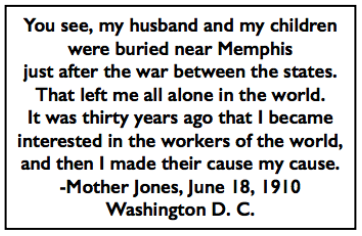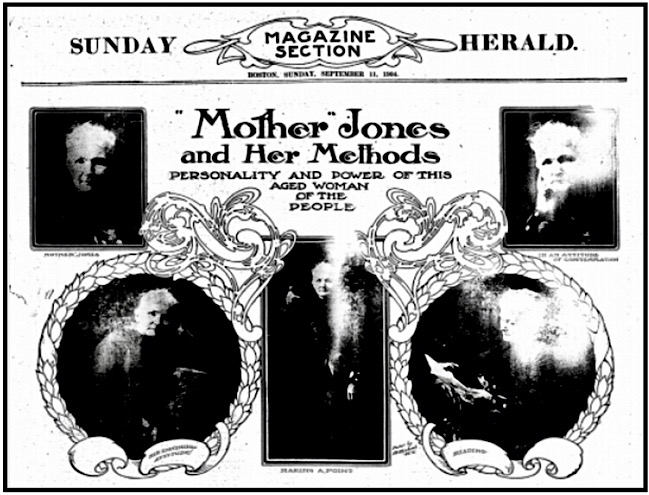 —————
—————
Hellraisers Journal – Wednesday September 14, 1904
Part II of III: “Mother Jones & Her Methods”-Then and Now
From the Boston Sunday Herald of September 11, 1904:
(FROM OUR SPECIAL CORRESPONDENT.)
NEW YORK, Sept. 9, 1904
Her Appearance and Her History
“Mother” Jones is an old woman, perhaps about 62 years of age. Her hair is white as snow, her eyes bright blue. She has a sweet, womanly mouth, and a pink flush in her cheeks. She is robust and healthy in appearance, with a good matronly figure. In dress she is quite plain, often almost shabby; though there is a neatness, almost a daintiness, about her which always gives her an agreeable appearance.
Her maiden name was Mary Harris. When she was a child of 10 she came to this country with her father and brother from Ireland. They lived for time in Provincetown, and afterward went to Canada. She was educated in the common and normal schools of Toronto, where her brother became a priest, and is now the dean of the archdiocese. She went to teach in a convent in Monroe, Mich., and later, going to Memphis, Tenn., to teach, she met an iron moulder, whom she married. They had two [four] children. She lost husband and children after a brief six years of married life in the yellow fever epidemic in the south.
After the war she went to Chicago, where she lived from 1867 until 1874, taking part in the relief work of the great fire as one of her first experiences in public work. She was a dressmaker in Chicago, as she was in San Francisco, where she lived for five years. In San Francisco she became interested in socialism, and took part in the anti-Chinese movement. When she returned East it was Mrs. George Pullman who secured her transportation. She had sewed for many women of wealth in Chicago, and had a large circle of friends among them.
Her life thus far had been comparatively simple. As a daughter she was obedient and studious, as a young woman a modest, retired teacher, as a wife, faithful and loving. She says of her married life that it was like that of most devoted wives. She wept if her husband drank a glass of beer after the day’s work or went to a union meeting at night. Yet she had enough intelligence to interest herself in his labor views, and imbibed her first notions of unionism from the protestations of her husband against her too devoted solicitude, and a great part of her effort in later years was to make women understand what she failed to understand in those early days, that the wife must care for what the husband cares for, and that every man loves freedom, even freedom from domestic tyranny.
Her remedy for lonely wives is a broader interest in the affairs of life. As a young widow she took pride in the trade she learned, and today she still loves to walk for an hour through the shops and look at beautiful silks and fine laces.
But though a good teacher and skillful dressmaker, it was not sufficient for this woman to provide for herself a good living and take no further thought of the world. She was aware that there were questions troubling the minds of men, and she wanted to help solve them. And somewhat later it came to her that she had the gift of eloquence. She discovered this in the old trades and labor assemblies in the West, where, when rising to take part in a discussion, a torrent of words would rise to her lips and her hearers would sit spellbound.
She belonged to the old Knights of Labor, and later took part in the organizing work of the American Railway Union, and became the friend of Eugene Debs. She was active in Chicago at the time of the Pullman strike, unmindful of the old-time friendliness of Mrs. George Pullman. Some years later she was able to secure a pardon for some of the men involved in the labor troubles of that great railroad strike by a personal interview with President McKinley at the White House.
—–In the South and Among the Miners.From Chicago she went to the South, and became a mill worker in Georgia and Alabama, and presently started the agitation against the prevailing conditions of child labor in the South writing a series of articles for Kansas socialistic paper called the Appeal to Reason. On returning North from this experience, she became acquainted with John Mitchell, and soon went to work as an organizer for the United Mine Workers. In her years of friendly relationship with Debs and Mitchell she has shown herself a respected and valuable ally to the two most noted labor leaders of the country.
For the past nine months “Mother” Jones has been working for Mr. Mitchell in Colorado, among the coal miners in Las Animas county. She has been repeating the old experiences of climbing up mountain passes in the cold of winter and in the heat of summer, sleeping where she could and eating the humble fare of the workers, travelling some days 40 miles in an open buggy and making speeches for three mass meetings a day. In Colorado she lay for weeks at death’s door with pneumonia, again was quarantined 16 days supposed exposure to smallpox [in Utah], and but recently was deported from the state when military law went into effect in that county.
The miners at once made her a special agent to solicit funds for their relief in the East, and she has been travelling through New England, addressing trades meetings, telling everywhere the dramatic story of Colorado and the great miners’ strike. And when this work is done she will go back to the children, for child labor lies upon her heart, and to remedy this social evil she confidently expects to devote the last years of her life.
Thus “Mother” Jones has become as conspicuous in America as Louise Michel in France. She is about 10 years younger than the famous French woman who, like “Mother” Jones, was a teacher in her youth, a social agitator in mature life, whom conventional society took measures against by banishment and imprisonment. “Mother” Jones has not yet suffered that sort of martyrdom, and doubtless never will, though she has been branded by her enemies as insane and immoral, neither of which allegations disturbs her serenity of mind.
“Mother” Jones has temperament to a pre-eminent degree. Some one has defined temperament as “the warm atmosphere of the soul,” but it is not in her case the gentle perfumed breeze of a walled-in garden. Temperament with her suggests rather the tropical trade winds blowing over the blue South seas, where the rise and fall of the ground swell is like the breathing of some great being. For “Mother” Jones can be either sunny and warm or tempestuous and full of elemental energy. This has been called the dual nature, but rather is it in this woman, as it is in all unusual natures, the many-sided character, the universal temperament, the diapason of fundamental harmony. When “Mother” Jones smiles and is serene, those who meet her for the first time imagine her to be a gently and lovable old woman. They have yet to see her aroused, when like the hoary ocean, she is lashed as if by a fury of the gods.
—–Attempt to “Conciliate” Her Failed.During the anthracite coal strike of 1902 the wealthy New York man, supposed to be “close to Mr. Morgan,” conceived the idea of conciliating “Mother” Jones and converting her to some plan which he had for settling the strike. He called on her at her hotel in New York, She was in one of her most tranquil moods that day, and seemed like the sweetest of old ladies. She came to meet the man of wealth, walking through the suite of parlors with the calm, high repose which she can so readily assume upon occasions.
She was wearing a black silk gown, touched up with hints of violet and relieved with soft white lace. Her hair, snowy, soft and wavy, was neatly dressed, her lips were gently wreathed in smiles, her blue eyes sunny, like the eyes of one’s grandparent looking upon the children of her children, with deep lights of strong affection. The caller was so impressed with her high-bred manner and air of the gentlewoman that he had a sudden inspiration to ask her to his home to dinner. “Mother” Jones accepted the invitation, and that afternoon the gentleman’s wife came to fetch her in their carriage. She went to the mansion uptown, there to meet a bishop, a resident of a social settlement and a distinguished political economist. The table was beautifully laid, and a dinner of many courses of delicate food and excellent wines served. But something had happened to change the mood of “Mother” Jones.
One can never be sure what has transpired to alter the view point of a nature such as hers. It may be that the afternoon had been spent in reading “Resurrection,” or “The Chant of the Captives.” At all events, “Mother” Jones regarded the several glasses at her plate, the different knives, forks and spoons laid to her hand, and perhaps thought of the bread and tea, coarse crockery and bare table of some home in the Pennsylvania mountains, where she had been entertained with the reverence due a saint by the toilers of the mines.
The soft murmur of voices of the dinner guests was suddenly disturbed by the rumbling thunder of approaching storm. It was “Mother” Jones speaking to her host unflatteringly and almost harshly. She had determined to tell him some truths about the conditions prevailing in the coal regions. The fact that she was a guest at dinner made no difference; a dinner was to her no more, no less, than a dinner, the necessary partaking of food at a given hour. The mood was upon her to speak.
All the guests listened while she painted one of her word pictures of glowing color and deep shadows. Such an event is regarded as an awkward circumstance by persons wedded to conventionality, and in this instance the shock was such to the mental poise of the guests that all idea of an amiable conference was abandoned, and the dinner ended without diplomatic result, but the wife of the wealthy host became a devotee to the doctrine of brotherhood.
[Emphasis added.]
SOURCE & IMAGES
Quote Mother Jones, Husband Children, WDC Tx p5, June 18, 1910
https://chroniclingamerica.loc.gov/lccn/sn84026749/1910-06-18/ed-1/seq-5/
The Sunday Herald, Magazine Section,
-of The Boston Herald
(Boston, Massachusetts)
-Sept 11, 1904
https://www.genealogybank.com/doc/newspapers/image/v2:1386BF60B4F67060@GB3NEWS-13A614B9A77E319C@2416735-13A5D68262641C21@36-13A5D68262641C21
See also:
Hellraisers Journal – Tuesday September 13, 1904
Part I of III: “Mother Jones & Her Methods”-Her Power Proved
Search: Appeal to Reason, Mother Jones, Child Labor
https://www.newspapers.com/search/results/?keyword=%22mother+jones%22+%22child+labor%22&publication-ids=2970®ion=us-ks&sort=paper-date-asc
Tag: Colorado Coalfield Strike of 1903-1904
https://weneverforget.org/tag/colorado-coalfield-strike-of-1903-1904/
Tag: Carbon County UT
https://weneverforget.org/tag/carbon-county-ut/
Louise Michel
https://en.wikipedia.org/wiki/Louise_Michel
Tag: Great Anthracite Coal Strike of 1902
https://weneverforget.org/tag/great-anthracite-coal-strike-of-1902/
NOTE: This reporter has a few facts wrong about Mother’s early life, most notably, she had four children, not two. Her husband and four little children all died in 1867. Mother rarely talked about the loss of her husband and children. She did describe that terrible loss here, in her autobiography:
https://archive.iww.org/history/library/MotherJones/autobiography/1/
She was, indeed, the sister of the famous Father William Richard Harris:
http://www.biographi.ca/en/bio/harris_william_richard_15E.html
The best source (thus far) on the early life of Mother Jones, I believe, is:
Mother Jones: The Most Dangerous Woman in America
-by Elliott J. Gorn
Hill and Wang, Jun 2, 2015
https://books.google.com/books?id=9gRpCAAAQBAJ
~~~~~~~~~~~~~~~~~~~~~~~~~

